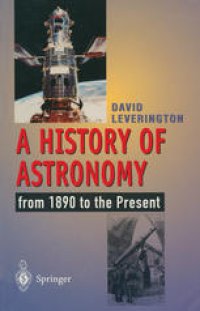
Ebook: A History of Astronomy: from 1890 to the Present
Author: David Leverington (auth.)
- Tags: Astronomy Observations and Techniques, Astrophysics and Astroparticles
- Year: 1995
- Publisher: Springer-Verlag London
- Edition: 1
- Language: English
- pdf
The history of astronomy is, like most history, a multidimensional story, and when writing about a specific period, the author has to decide how to handle all the developments of earlier times in order to set the scene. I have done this by starting most chapters of the book with a summary of astronomical knowledge at the beginning of our chosen period, together with a brief review of how such knowledge had been gained. This story is not only interesting in itself, but it will also assist those readers that would appreciate a brief reminder of some of the basic elements of astronomy. It is also necessary to decide when to start our history. Should it be the year 1900 or 1890, or should it be linked to some key development or investigation, e. g. the discovery of the electron by J. J. Thomson in 1897, or the discovery of spectroscopic binary stars by Pickering and Vogel (independently) in 1889, or maybe the year 1890 in which Thomas Edison tried unsuccessfully to detect radio waves from the Sun and Johannes Rydberg published his formula for atomic spectra? I have, in fact, decided to start this history at about 1890, as it was the year of publication of the Draper Memorial Catalogue of stellar spectra which, together with its updates, provided essential data for the understanding of stellar spectra until well into the twentieth century. This date also gives a clear hundred years up to the present.
Why start at 1890? That year marked one of the most significant dates in the history of the multidimensional story that is the history of astronomy. It was the year in which the Draper Memorial Catalogue of Stellar spectra was published - a publication that provided essential data for an understanding of stellar spectra well into the twentieth century. It's also slightly over a hundred years ago. This is a long enough span of time for any one book on this subject to cover, but sufficient to chart the progress of astronomy from a time when Newtonian physics reigned supreme, photography was in its infancy, and radio astronomy was decades in the future. Paradoxically, the theories of Einstein, Planck and Heisenberg, along with modern radio, X-ray, and space-borne telescopes mean that the cosmos seems to hold more mysteries today than it did a hundred years ago. Any reader with a basic knowledge of astronomy will find this book quite fascinating. Academics, historians, and others who need a definitive history of the major events and characters that influenced the growth of astronomy.